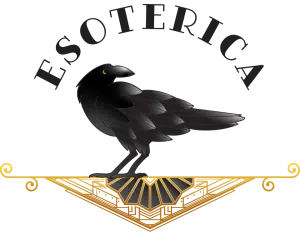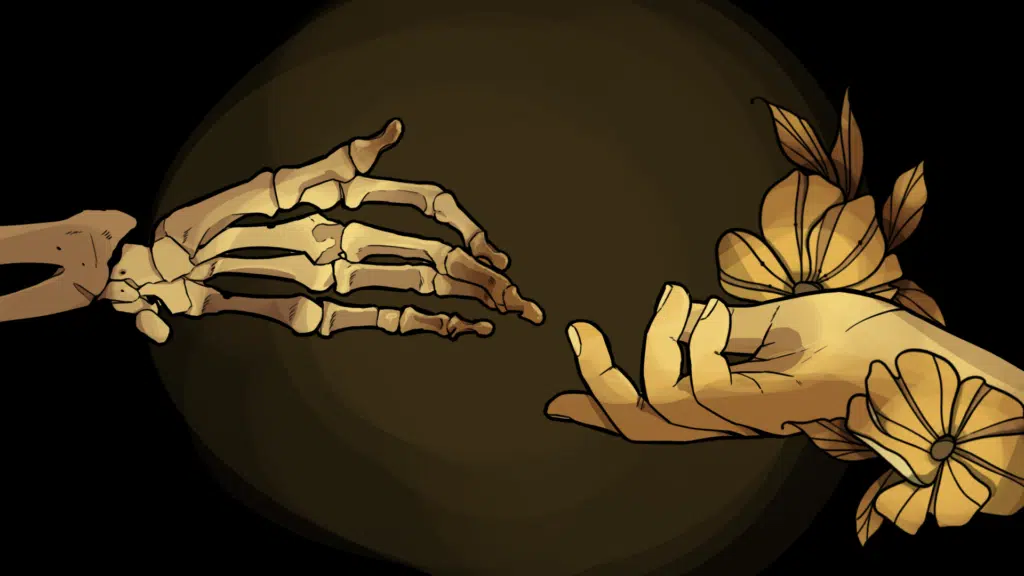By Sarah Royalty Pinkelman,
A modern, brutal graphic—tiny dots of ink cover a rectangle, like a channel that can’t transmit a signal. The February 2021 New York Times graphic of a half million U.S. lives lost to COVID-19 needs doubling, wet ink, folded in half in a kindergarten art project. Not oblong, those dots, like rice or the bacillus bacteria. Round and fuzzy, buzzing, something organic, traces of living matter left, an echo of an attempt to rearrange. Now that we surpassed one million dead, how will they continue to capture the tragedy?
Art historians use “organic” when describing certain architectural styles and techniques, like the entasis of ancient columns with the slight bulge in the center evoking a straining muscle. Bulging architecture appears in ancient examples worldwide, from Incan walls to Nubian temples to Tibetan monasteries. Organic architecture indicates there’s an aura of lung capacity in a structural design. Sometimes all it takes for matter to seem alive is a well-placed curve.
And so any death-by-Covid graphic with variations in dot density evokes movement and evolution of one thing become another. This is how I imagine cells inside a chrysalis—random and scurrying, grouping and separating. The caterpillar literally digests itself, releasing enzymes that dissolves its voracious tissue, then forms wings and new segments, revamped entablature.
How quickly we want an image of death to become one of rekindling and new life, of transformation. How hard it is to sit with the loss. How difficult it is to come up with a way to commemorate that honors the truth of disappearance. Memorials can insist we pause, stop, remember—turn not away.
Here was a graphic of death created so readers might internalize what (then, only) half-a-million dead—looked like, not a figure on its way to becoming a butterfly; we strain to comprehend it with our musculature. We wrestle to be still before an image of death in data points. And we often send our most gifted artists to capture it in befitting ways so we can stand before mass death and remember; before the yawning, weeping cavern of the 9/11 memorial; before the reflective sheen and sharp angle of the Vietnam Veterans Memorial wall; and before the hanging, stark, steel monuments to the victims of racial terror and lynchings at the National Memorial for Peace and Justice.
Who and how we mourn tells us a particular society’s story: when we find it worthy on a large scale to stand still before certain deaths. One of the oldest cities ever excavated is called Çatalhöyük, located on the Anatolian peninsula in part of what’s now Turkey. The society occupied the area for over 1,000 years, from around 7100 to 5950 cal BCE. Bioarcheologists discovered that this society buried their dead beneath their floors in their domestic living structures. Scientists have been shifting through the bones, trying to learn about the society’s funerary practices.
Significantly, more skulls were found among the buried bones than lower skeletal parts. In other words, the ratio doesn’t match. There are several possible explanations, but definitive identification of the roll these skulls played, some decorated with ochre, is difficult. In Çatalhöyük, and in other ancient sites all over the world, as researchers Scott D. Haddowa and Christopher J. Knüsela write, it’s difficult to “differentiate between the skulls of ancestors and enemies based on treatment alone.” They go on to sight examples, pointing out that “distinguishing veneration from violation based on the manner in which bodies of the deceased were manipulated is difficult because the treatments mimic one another, despite clearly separate intentions on the part of participants.”
As we surpass one million, we are grappling with the skulls of our ancestors and enemies, awkwardly working toward representing our dead, stymied by the pain of love and hate. It’s tempting to harken to less divisive times, but where and when are these times? Cruelty is almost as old as love. Our technology is new but the acts are ancient.
When former President Obama visited the ancient hominid bones of Lucy in 2015, he reminded us that we all share the same ancestors, the same beginnings, and made a logical call for unity. But in very close quarters, among family, our enemies keep popping up, brother against brother. We fight over flour in the supermarket among our own tribe, hoard toilette paper and bags of rice in our cellars from our neighbors. Rice, flour, grains: ancient foods and fields that witness our battles.
I still have a large bag of rice I bought sometime in 2021 with relief, knowing we’d get our starch, have something to absorb the flavors of the meal: culinary balance hoarding. I still dip into the bag with pleasure, enjoy the sifting of dried grains, the swish of the measuring cup and the feeling of surfeit. It wasn’t until a friend with Korean heritage clued me that I learned to rinse rice before cooking. Like many white Americans, I’d been raised with cardboard box hygiene equivalency and had no connection to the process that is rice.
Now, I savor splashing water in a bowl and swishing the grains back and forth, watching the water turn cloudy. Every time I rinse it, I think of my friend’s loving scold, caring enough to scoff at me, and her parents who pushed through a war-torn country to come here, bringing up their child with better food security than they had; yet my friend also faced little white kids chanting “I’m turning Japanese,” laughing, outside the ice cream store in their school uniforms. This rice is crowded with stories of benefits and loss.
Little blobs, stars in the sky, grains of sand, limitless possibilities: we like to gaze at such things. They’re beautiful: they promise plenty and evoke multiplication. There’s always more, there’s always reproduction. On a cellular level, division enables growth, the means to multiplying, and the path to multicellular life. Yet, here our enemy also pops up and invades, a virus coopting cellular machinery.
Modern evolutionary biologists often point out that evolution is not the same as progress or advancement, but they do evoke the term “arms race” as a force that determines traits. We become what makes reproduction work successfully. And the connection between multiplication and progress is hard to shirk. So we examine societies for successful traits.
Bioarcheology makes a lot of the switch between human populations setting up societies with domesticated agriculture and animal stock versus the hunter/gatherer life. The Çatalhöyük settlement existed in the early part of the Holocene era. Such groups distinguished themselves by their sedentary agricultural habits. They’re among the first to stop the constant mobility, settle, and raise food.
However, Larsen et al. note the cost of domestication and settling down. In fact, “Study of Çatalhöyük human biology reveals increasing costs to members of the settlement, including elevated exposure to disease and labor demands in response to community dependence on and production of domesticated plant carbohydrates, growing population size and density fueled by elevated fertility, and increasing stresses due to heightened workload . . . including health challenges, adaptive patterns, physical activity, and emerging social behaviors involving interpersonal violence.” Sounds familiar.
Proximity and stasis leads to diseases and virus spread. Labor systems on a mass scale lead to overworking and bodily strain. We place demands on faceless members—large anonymous groups like nurses, bus drivers, and teachers—unhealthy workloads and overly sedentary ill-health effects. Larsen et al. add, “Ultimately, the foraging-to-farming transition created the conditions leading to the so-called ‘diseases of civilization’ (e.g., cardiovascular disease, cancer), dental–oral infections, and a range of crowd-based infectious diseases and systemic conditions killing millions at various points in human history and for the foreseeable future.”
While they held onto the sculls of their enemies, they were also targeted by trappings of their lifestyle, by the deals we make with a settled life. Another very different group has also left a significant burial site for investigation. About two centuries after the Çatalhöyük settlement was no more, pastoral and nomadic groups were creating their own mass cemeteries in eastern Africa in what is now Kenya. The recently excavated Lothagam North Pillar Site stands as the largest.
A study undertaken by archeologist Elisabeth Hildebrand investigates the monumental burial site, built about 5,000 years ago. The Lothagam North Pillar consisted of a massive platform with an opening or “cavity” in its center. Over centuries, nomads placed their dead in the center along with personal ornaments like pendants and earrings.
Here, there was “no evidence for social stratification. The uncertainties of living on a ‘moving frontier’ of early herding—exacerbated by dramatic environmental shifts—may have spurred people to strengthen social networks that could provide information and assistance . . .[forming] an arena for interaction and a tangible reminder of shared identity.”
People on the move needed this touchstone to offer cohesion and comfort, a sense of closeness and stability in the midst of constant movement to stay alive. Yet the Çatalhöyük people, literally entrenched in togetherness, developed disease from constant stability, infections from too much identity shared.
The average citizen in our modern economically-advantaged societies seeks ergonomic transportation and ways to stay still without it hurting quite so much. While settled societies tend to assign terms like progress and advancement to ourselves, it’s always been worth investigating that assumption and understanding how evolutionary forces get coopted by ideologies, even when we look to our shared biology to bring unity.
Phylogeneticists have given us their version of ancestor worship with L.U.C.A., the last universal common ancestor, a signifier at the base of the phylogenetic tree of life. LUCA is a theoretical construct, not the first living cell, but the last before paths divided, an intermediary between abiotic earth and multiple-life-form earth. The trees, the worms, the wolves, the slime molds, Bacillus subtilis, humans—we all share a common ancestor, some type of cell from which all present day life evolved and before evolutionary paths divided.
Eventually, some cells evolved to join together and become one organism composed of many—multicellular life, a Borg contingent. Evolutionary pressures to survive meant some lone cells found better success by sticking together while others, like bacteria, kept going quite successfully as single-celled organisms. And with multicellularity and rapid growth, cells increased likelihoods of mutations and cancer, death from crowded conditions. This is a part of our history at the most basic level.
I wonder about that intermediary place, that tension between individual cell and conglomeration and what the energy from the pull between the two, gathering and dispersing like wings, releases. That’s the space of poetry and science.
The chrysalis dissolves all its cells except for a select group called the imaginal discs. These cells, present in most insect larva, create the image or components of the adult butterfly, from wings to hinge to thorax. It’s no wonder metamorphosis is central to mysticism and spiritual growth: the idea of regenerating into something grander that can leave the confines of the earth, soaring above rather than clinging to the twigs and sticky substances below. But scientifically, metamorphosis, for insects, describes the path to adulthood.
We watch the hundreds of thousands of tiny dots of Covid deaths grow, while the radio reports battles in the background, and attempt to sit still with the loss of ancestors and enemies, try and forgo the rearranging into caterpillar life cycles, but that stillness is elusive. The wings continue to form, and we can’t grasp this knowledge or forestall the next stage of becoming.
Those left behind will always face death like this, parading our skulls, dividing and multiplying, returning too quickly to motion, because that’s what life is, what we all share, the same instinct in the scent of our neighbor and enemy, the wild wolf at the door: the force behind the wide-eyed desire to live.
Sarah Pinkelman is the managing editor at the Ann Arbor Observer and have published poems and short stories. I also write freelance science articles with a specialization in environmental impacts on animals.

